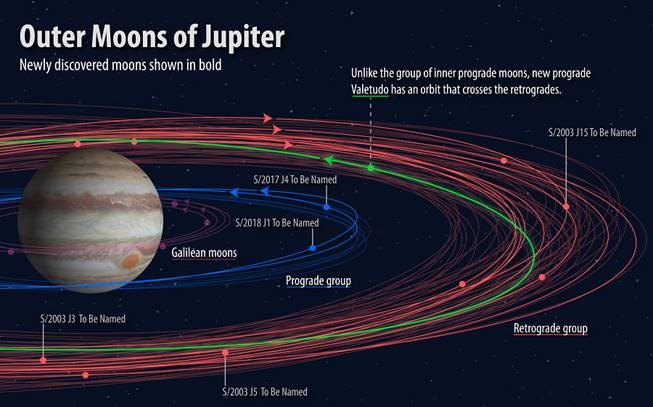Washington, DC—In July 2018, Carnegie’s Scott Sheppard announced the discovery of 12 new moons orbiting Jupiter—11 “normal” outer moons, and one that he called an “oddball.” This brought Jupiter’s total number of known moons to a whopping 79—the most of any planet in our Solar System.
Now the public can help Sheppard and his co-discoverers select the names for five of these newly announced moons!
“I’m excited to get suggestions—and especially eager to see video suggestions—from the public for what these five moons should be named,” Sheppard said.

DETAILS:
Contest Launch Date:
February 21, 2019
Contest End Date:
April 15, 2019
How To Submit:
Tweet your suggested moon name to @JupiterLunacy and tell us why you picked it using 280 characters or fewer or a short video. Don’t forget to include the hashtag #NameJupitersMoons.
The General Rules:
– Jupiter Moons must be named after characters from Roman or Greek
mythology who were either descendants or lovers of the god known as Jupiter
(Roman) or Zeus (Greeks).
– Submissions must be 16 characters of fewer, preferably one word.
– Submissions must not be offensive in any language or to any culture.
– Submissions must not be too similar to the existing names of any moons or
asteroids.
– Names of a purely or principally commercial nature are prohibited.
– Names of individuals, places, or events that are principally known for
political, military, or religious activities are not suitable.
– Names commemorating living persons are not allowed.
The Rules for Each Individual Moon:
– S/2003 J5 (Jupiter LVII) which is retrograde and thus name must be
related to Jupiter or Zeus and end in an “e.”
– S/2003 J15 (Jupiter LVIII) which is retrograde and thus name must be related
to Jupiter or Zeus and end in an “e.”
– S/2003 J3 (Jupiter LX) which is retrograde and thus name must be related to
Jupiter or Zeus and end in an “e.”
– S/2017 J4 (Jupiter LXV) which is prograde and thus name must be related to
Jupiter or Zeus and end in an “a.”
– S/2018 J1 (Jupiter LXXI) which is prograde and thus name must be related to
Jupiter or Zeus and end in an “a.”
Learn More:
Further details about how the International Astronomical Union names
astronomical objects can be found here.
This video details some of the possible Jupiter moon
names and can tell you more about how the Jupiter moon-naming process
works.
Make Sure Your Proposed Name Is Not Already In Use:
– Current Asteroid names can be checked at the International Astronomical Union’s Minor Planet Center here or here.
– Existing names for Jupiter’s other moons can be checked at Sheppard’s website here.

The Carnegie Institution for Science (carnegiescience.edu) is a private, nonprofit organization headquartered in Washington, D.C., with six research departments throughout the U.S. Since its founding in 1902, the Carnegie Institution has been a pioneering force in basic scientific research. Carnegie scientists are leaders in plant biology, developmental biology, astronomy, materials science, global ecology, and Earth and planetary science.
